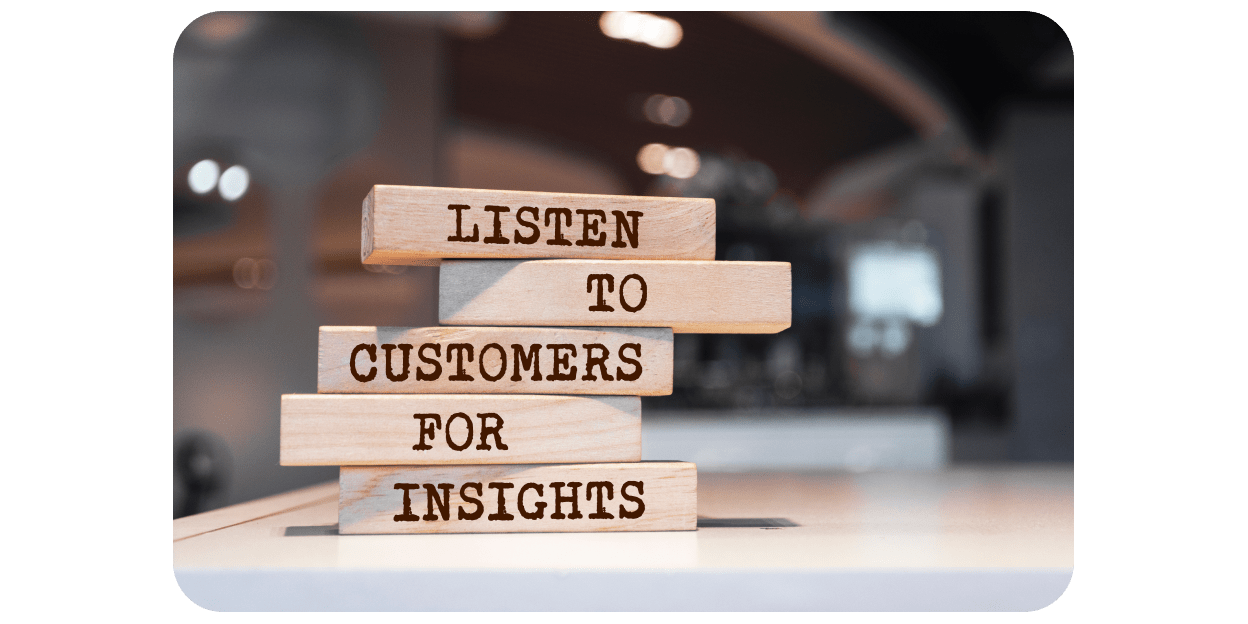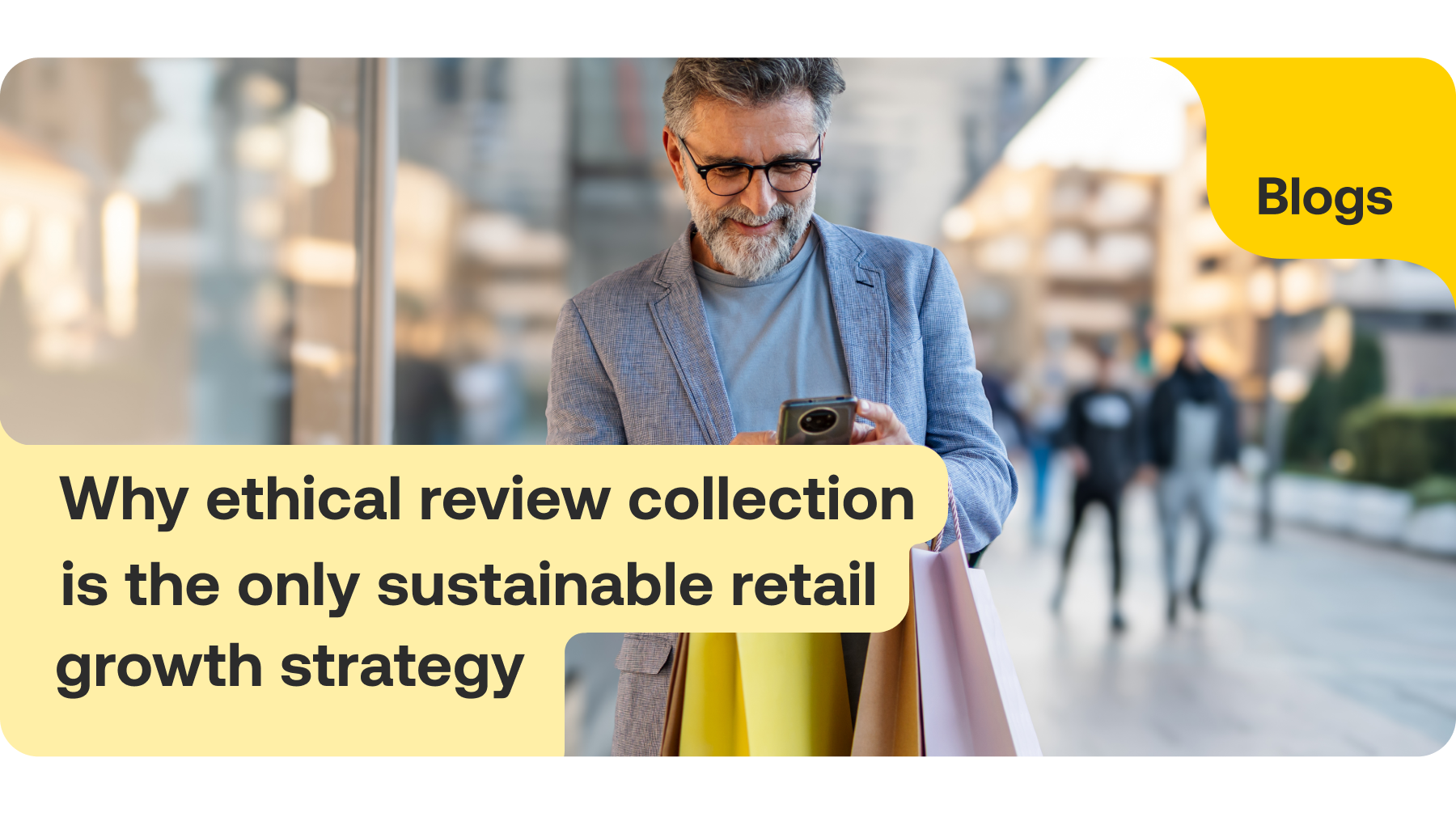Sourcing accurate data is the key to unlocking consumer insight. But collecting the information is just the start. You’ll need a customer insight strategy to listen, to understand what your customers’ data tells you and take action as a result – something that many businesses still find a challenge.
Gone are the days when you could cast your net wide, hoping to attract customers. In a changing world, customers expect companies to see them as individuals. A 2022 Accenture study found 64% of consumers wish companies would respond faster to meet their changing needs.
Using a targeted customer insight strategy can significantly move you ahead of the competition by turning consumer insight analysis into marketing that really resonates with your audience. You already see businesses from supermarkets to streaming services sending you personalised recommendations off the back of customer insight. And with more tools than ever available to help you understand your customers’ needs and wants, you can use this targeted approach too.
What is customer insight?
A customer insight is an observation on the behavioural patterns of your customers. You can draw customer insights from analysing customer data and feedback.
To perform this analysis, you need high-quality, accurate data. At Feefo, we often talk about the importance of using verified reviews as it means you can rely on the data and feedback that they provide when you're conducting customer insight analysis.
Consumer insight research aims to help businesses understand how their customers think and feel. It’s an analysis of patterns of human behaviour, which you can use to drive business strategy and as marketing insight in order to meet your customers’ needs.
Benefits of using consumer insights
Customer insights allows businesses to understand:
What:
- Issues their customers face
- Their brand experience feels like to customers
- Areas need improvement
How to:
- Improve conversations with customers from sales teams
- Increase sales team effectiveness by targeting qualified prospects
- Grow sales to new and existing customers
- Deliver higher returns on marketing and promotions investments
Consumer insight is the starting point for a whole range of business decisions. No two businesses will have the same findings, or the same objectives.
Examples of how businesses can action consumer insights
Here are some consumer insight examples of how small, medium and enterprise businesses could make valuable changes using their customer insight:
Case 1: Coffee loyalty cards
With increasing competition from larger chains, the owners of a small independent coffee shop were looking for ways to keep hold of their customers. By using Feefo’s On-Location Feedback tool, they were able to implement customer reviews and ask their customers questions about their products and service. When looking through the most used terms and phrases in the data, they noticed a reoccurring theme. Customers loved the coffee and the ethics behind the brand but were used to using loyalty schemes at bigger coffee chains. The coffee shop introduced a loyalty card scheme – a simple change that quickly gave them back their edge, and saw the number of repeat customers quickly increase.
Case 2: Strengthening any weak links
A car dealership, with ten sites nationwide, noticed some disparity in the sales figures they were seeing across the different sites. They didn’t just want to know why some were performing better than others, but they also wanted to bring all the figures in-line with the highest performing locations. The business started collecting customer reviews, and quickly realised that certain dealerships were suffering due to poor customer service. The business sent surveys out to their staff, and the results showed that the staff in the worst performing dealerships felt they could benefit from more training. Customer service training was rolled out in all the weaker locations, and sales gradually began to rise.
Case 3: Reviews highlighted the real issue
A holiday company found that they were getting poor reviews for the trailers at one of their properties. At first they assumed that the trailers themselves needed refurbishing and allocated a substantial budget to refresh them. But when they analysed their Feefo review data more fully, they found that the poor reviews were from trailers in one particular location of the park - a more shaded location that didn’t receive any direct sunshine.
So, they moved the trailers to a different area, where there was more natural light. Review sentiment subsequently improved – saving them thousands of pounds on a refurbishment that wouldn’t have addressed the underlying issue.
Case 4: Delayed delivery leading to increased returns
A well-known online gift retailer noticed that they were experiencing a sudden peak in returns, so started collecting customer reviews to find out why. After analyzing the insight, they noticed that the majority of the negative reviews were about gifts arriving too late, often missing the occasion and then ending up being useless. The business had recently swapped courier companies, so took swift action to return to their previous delivery provider. A few weeks after, the returns had plummeted, and posts from unhappy customers on social media quickly got lost amongst the positive ones.
Market research insights vs consumer insights: what vs why
One of the major benefits of consumer insights is that it can help you target your marketing activity more effectively. Both market research and consumer insight can provide useful marketing insights, but they look at different questions.
Market research insight defines the size and shape of the potential market for your product or service. It includes a look at competitors as well as the number of potential customers. It provides you with the raw data about what is happening in your sector.
Consumer insight also provides knowledge, but it’s linked to an understanding of your customers – their motivations and desires. It provides the rationale behind customer behavior, such as why they are making particular choices. So, consumer insight highlights where you could make changes to your business in order to improve customer satisfaction.
Packaging specialists, Invopak use Feefo’s platform to do just that, Customer Service Improvement Manager, Stuart Rolfe commented:
“Feefo give us real insights into customer experience, revealing factors we would never uncover by other means. It gives the customer a voice and provides us with ways of measuring our success we never had before. We have a far greater understanding of our customer experience than we ever did.”
Read the full Invopak case study.
How to develop your own customer insights strategy
In order to make the most of the consumer insight you’ve gained, our seven-step guide walks you through how to create your customer insight strategy.
Define your business objectives
You need to know what your business is really aiming to achieve from examining your customer insight strategy. This could relate to part of a process – for example, why basket abandonment is high or why you are receiving a lot of returns – or a desire to improve the return on investment of your marketing campaigns.
Get input from every department in your business to work out which areas you need to focus on as a company, what needs prioritising and where you can make the greatest impact.
Once you’ve got a clear list of objectives it will help you ask the right questions of the right customers, at the right time.
Put a timeline in place to gather consumer insights
Every effective strategy needs some deadlines. In the case of your customer insight marketing strategy, you’ll need to consider:
- How long you’ll be gathering customer insight for
- When you will be analysing the data
- When the results will be communicated to the key stakeholders
- When you will implement any new actions as a result of your customer insight
Make sure you’re realistic when you set your timelines. Take into account any barriers that might slow down the process, such as resources, budget and any potential slow periods of business.
Outline your target audience
You’ll need to refer back to your business objectives to work out who exactly you are hoping to collect customer insight from. For example, you might want to know which of your stores is performing best. In this case you’d need to ask customers from a particular region about their in-store experience once they’ve visited.
It’s not all about collecting data from your existing customers – some of the most useful insights come from those who haven’t dealt with your business yet.
For example, if you want to get a good idea of how your brand is perceived from an outsider’s point of view, then gathering insight from potential customers is a good way to go about it.
Mapping the customer journey
The next step in your customer insight strategy is all about putting yourself in your customer’s shoes by creating a customer journey map.
Knowing how, when and where people come into contact with your brand means you can start to pinpoint exactly when in the customer journey you need to collect customer insight to get the answers you need.
You’ll need to plot every single touchpoint in your customer’s journey – from the first time they see or hear from your brand all the way through to the customer service you give them after they’ve bought from you. Through each of these touchpoints your customers will have lots of different experiences which shapes their opinion of your business – and that means lots of valuable customer insight there for the taking.
Every customer journey map will be different, so there’s really no right or wrong way to do it, so long as you’re thorough. Here are a few pointers to get you started:
- Keep your different customer personas in mind. Not all of your customers are on the same journey. If you have lots of different customer personas, start with your most common
- Get the whole team involved. Customer journey mapping isn’t just about how customers interact with your website – it includes everything from paid ads to customer service and sales calls
- Make a note of all the actions your customers have to take. This helps you to understand what you expect your customers to do to achieve their goals. If you can simplify this journey, that would be a positive result
- Collect insight as part of the process. Using surveys, for example, can help you add some reasoning and emotion to your customer journey map to help you realise why your customers are making the decisions they’re making; whether it’s clicking away from your website too soon or taking the long way round before they hit the checkout
Collect your customer insight
You’ve homed in on the areas that you need to improve and the right places to ask for feedback – now it’s time to start collecting your customer insight.
There are lots of different ways of collecting customer insight, all of which can be grouped into two main categories; quantitative and qualitative.
Quantitative customer insight
- Helps you answer questions such as who, what, where and how many
- Data can be easily transferred into numerical values and displayed as charts, graphs and tables
- Customers often don’t need to spend as much time providing data as other methods, as it usually involves questions that are quick to answer
- Answers are standardised, so comparing and analysing the findings is straight-forward
- Surveys are a good way of collecting quantitative data. By asking closed-ended questions, such as ‘How old are you’ or ‘Where did you find out about our business’, you can quickly gauge anything from who your customers are, to how satisfied they are with your customer service, all on a numerical scale.
Qualitative customer insight
- Looks beyond numbers and figures into the ‘whys’ and ‘hows’
- Often provides the reasoning and context behind the data, giving you rich, descriptive data
- This insight is better when looking at human behaviour
- Collecting qualitative data can take a little longer than other methods
- Surveys can be used in this way too. A mixture of closed and open-ended questions can be the recipe for well-rounded customer insights. Your closed questions are there to give you the hard facts, whist follow-up, open-ended questions are designed to go further to explore the reasoning and gain some context
Collecting customer reviews is another great way of getting plenty of qualitative insight from your customers.
You can choose what to collect feedback on – could be the products you sell, the service you provide or individual stores and branches. Tools such as Feefo’s Feedback Request Manager tool supports you to pinpoint exact moments in the customer journey to ask for feedback and when to send those requests. Giving your customers the opportunity to share their thoughts in their own time means you’re likely to hear how they really feel.
Another tool to support with collecting customer insight is Net Promoter Score. This asks your customers whether they would recommend your business on a scale from 1-10 to determine if they’re ‘detractors’, ‘passives’ or ‘promoters’ when it comes to your service. This can be sent out as part of your feedback requests, so not only can you plot where you stand on the scale, but you can also take a deeper look into the sentiment behind the scores by checking what your customers have said in their reviews.

Analyse your customer insight
Once you’ve gathered your customer feedback, analysing the data is straightforward with the right tools to support you.
Use the following principles to help you sort through the data:
- Analyse everything - both positive and negative
You need to include all the data in your analysis. While sifting through your negative feedback may not be pleasant, negative reviews can actually work wonders for your business as they can highlight where there’s room for improvement. Find out how to make the most of them
- Categorise your feedback
Categorising your customer insight into themes helps provide structure to the feedback. Identifying the most reoccurring themes in your feedback, whether they’re mentioned in a positive or negative light, will help you figure out what’s being talked about the most. Putting your customer insight into categories may even highlight some areas that you didn’t even know were causing issues.
Every business is different, and the right categorization tags for you will depend on what you provide, and what your business objectives are that you set out in step one.
Feefo’s Insights Labels tool allows you to tag and track themes across your customer reviews, so you can discover what people are saying about your business and make the changes that matter.
“Insight tag reporting across all our customer feedback has given us fantastic insight into our business. It lets us recognize trends, quickly identify customer concerns, and monitor customer experience initiatives across the business”.
Adam Cornish, Customer Experience Manager, Expedia
- Identify the trends
Identifying trends is where you discover exactly where you’re hitting the mark, and which touchpoints could do with some work.
So, how do you go about spotting these trends in your customer insight? If you’ve got time to spare, then you can sift through the content manually. But it’s probably best to let software do the hard work for you. Not only is the process infinitely quicker but it also eradicates the chance of human error and bias.
Feefo’s Customer Sentiment Insight tool automatically analyses your customer feedback, identifies sentiment and gives you an at-a-glance view of the main issues that are affecting your customers. Performance profiling can instantly analyse your customer insight with:
- Sentiment score: your sentiment score shows the level of positive and negative emotion that’s within your review content.
- Performance graph: this groups your customer feedback into four sections; advertise, focus, monitor and potential, so you can see which areas of your business you should promoting in your marketing and which need more attention.
- Automated sentiment trend analysis: track how your sentiment score changes over time as you receive more customer insight.
- Review snippets: find out which common keywords are used in your customer feedback, and use them to build more engaging PPC ads.
“We wanted the ability to show we listen to our customers and Customer Sentiment Insight has given us the perfect opportunity to connect and demonstrate our fantastic customer service. It has helped us to see what we could do to improve our delivery processes and opened up some really interesting conversations between us and Our Customers. The conversations were fed back to the relevant decision makers, who were then able to take action and improve the customer experience”.
Rachel Lewis, Customer Response Co-Ordinator, Iceland
Choosing the right consumer insight tools
With so many consumer insight tools available, choosing the right one for your business can feel overwhelming. The key is to find a solution that not only gathers data but provides meaningful, actionable insights that drive real improvements.
Some businesses still turn to traditional market research methods, such as surveys and focus groups - which are still very relevant, but are more resource-heavy. Others harness advanced analytics platforms that track customer behavior in real-time. Social listening tools, for example, allow brands to monitor online conversations and sentiment, helping them stay ahead of emerging trends.
However, when you're choosing your consumer insights tools, it is important to remember that not all data is created equal. The most effective insights come from verified, trustworthy sources - which is where Feefo stands out. Because we collect only genuine customer feedback, we can provide businesses with rich, unbiased insights that reveal what customers really think. These insights go beyond simple star ratings; they offer deep analysis on key themes, customer sentiment, and emerging trends, helping brands make informed decisions with confidence.
Choosing the right consumer insight tool isn’t just about data collection; it’s about having the right information at your fingertips to build better customer relationships, improve experiences, and drive long-term success.
Take action
All the insight in the world counts for nothing until you turn it into action to improve your product or service for your customers.
But your decision-making process should be a whole lot more straightforward with the data to back up any changes you bring into your business.
In conclusion, customer insights are perhaps the most valuable thing that you can own as a business. Having them means you can:
- Find out how both potential and existing customers perceive your brand
- Take a deeper look into your customers’ buying decisions
- Build long-term relationships with your customers
- Make meaningful changes in your business, which your customers will love
If you'd like to uncover how strong your customer insight strategy is, take our two minute business questionnaire - with 10 easy questions, you'll receive actionable advice based on the outcome.



